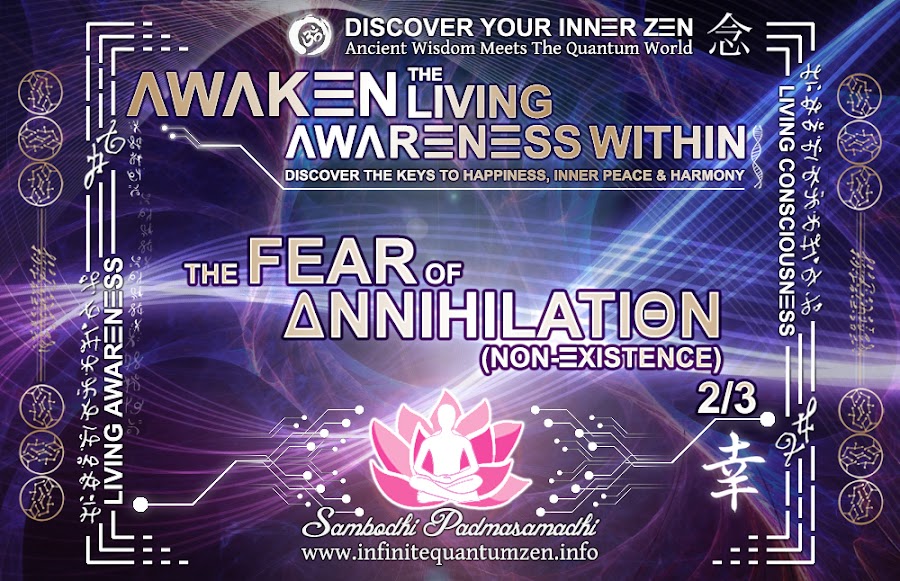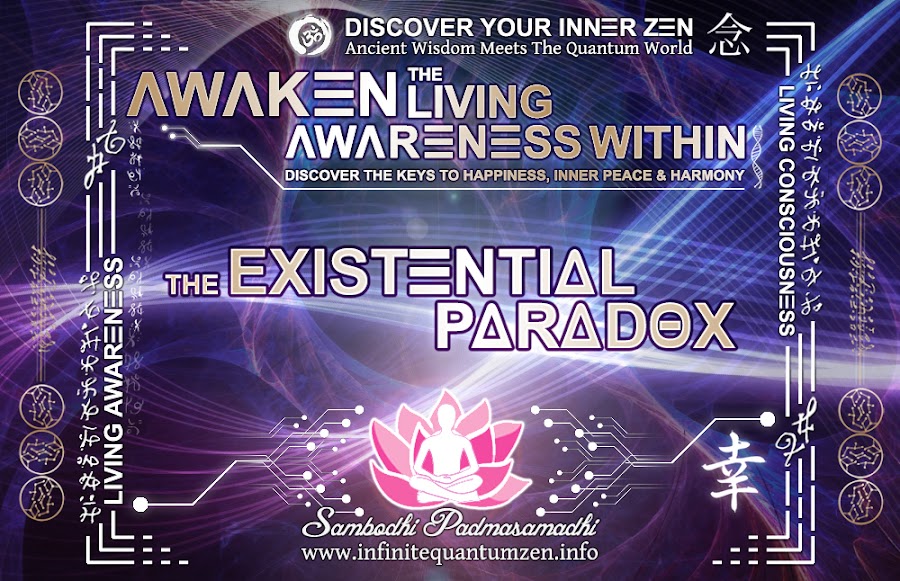 |
| ~ ∞ ~ The Fear of Annihilation (Non-Existence) ~ ∞ ~ |
As mentioned earlier, no matter how we look at it, it does, indeed, seem that one of the biggest fears we humans have is the fear of a total annihilation, or non-existence – we will come back to this in a moment, but first, let us take a look at some of the causes behind it. As much as this is true, that we humans fear non-existence, there is another fear that is much worse – the fear to be who we truly are. Because of this, yet another one surfaces – the fear of rejection.
These fears are inseparable and go hand in hand – feeding each other, creating a vicious cycle of worthlessness. Partly this is due to our modern science which holds a view that out of nowhere, for no apparent reason, nothing spontaneously became everything – without any purpose, and without any meaning. Supposedly, according to this view – humans are nothing special in the context of the cosmos – as if the Earth and its inhabitants were just a big “cosmic accident” of some sort.
And it doesn’t stop there, for you see, this same worldview also holds that the entire universe is without any intelligent design whatsoever, and hence without any purpose or meaning. Is it any wonder, then, that the fear of death, the fear of one’s life to be finite, the fear of total annihilation (non-existence) prevails?
Is it any wonder, then, that most humans define their own existence as individuals to be an accident based on randomness; that in their ignorance and hubris they believe that there’s not one scintilla of evidence that any other factor was involved in their creation? Is it any wonder, then, that all too many have convinced themselves into thinking that there is no meaning, no significance, no purpose, and no manifest destiny to human life?
In part, this is the result of scientific materialism – a view that physical reality is the only reality there is; that all things are composed of material, and all phenomena (including consciousness) are the result of material interactions; that the brain creates consciousness and that consciousness cannot survive without the brain; that the death of the brain is the death of the individual and the death of consciousness.
The lens through which we perceive the world and ourselves has a tremendous effect on us, both individually and collectively. As a result, we begin to formulate a belief that we are only these limited physical bodies and mind. This belief begins to ingrain in us the idea that we are nothing but a product of an amoral, evolutionary process – an accident, if you will – insignificant creatures in a vast cosmos; and because of this, we live in constant fear that the limited self we have identified with – will die, cease to exist, and return to nothing.
If we really stop to think about this, we can see that science is not only a tool we have invented to make sense of life, but also a story, a narrative, through which we try to create permanence for ourselves within an essentially transient world; through which we try to find meaning into our seemingly purposeless lives.
In light of our growing mastery over so many aspects of the physical world, it is not unsurprising, then, that many have come to place all their hopes in science, and even to believe that happiness can be achieved by means of what material science can deliver – hoping to find solace in scientific explanations, most of which are based on the unfounded assumptions, models and predictions, claims and promises that very rarely, if ever, come to pass.
One might even say that science is useful but dangerous tool that promises to give us purpose and meaning, and in this sense, science is no way different than the numerous religions of the world, which all in their own ways are promising the salvation from ourselves.
As a result, we human beings seem to hold a belief that life is some kind of an accident that just happens to us, rather than something that happens for us. This belief is extremely harmful in more ways than one. You see, as a result, we are accustomed to assume that we only have this one life, and what awaits us after we die – is nothing; thus the saying “You Only Live Once,” or just simply “YOLO.”
This kind of thinking encourages moral irresponsibility and material hedonism, which in turn results in nihilism, which denies the existence of genuine moral truths and asserts the ultimate meaninglessness of life or of the universe. So, what about this instead: “We only die once, and we live every day.”
This simple change in one’s thinking can bring about lasting change, it can be transformational to say the least. Other than that, this belief that life is some kind of an accident puts us in a victim mentality, in which we believe that we are powerless in the world, and that we have little or no power at all to change things.
If we really stop to think about the aforementioned, we can find that in all actuality, life is something that happens for us, and through us – reflecting everything we believe to be true for us, just like a mirror does, you see? Nevertheless, many people live in a world where they feel they have no control, feeling powerless and abandoned by the world; deep inside they are afraid – especially of death. They constantly search for the meaning of their lives, feeling alienated, vulnerable and all alone.
So, if we take the previous into consideration, is it any wonder, then, that we hold a belief that we are born from nothing, and when we die, we mysteriously once again become nothing; and that our entire existence is only a life-span – beginning from the moment we are born, and ending at the moment we die. From this, the question arises: How far have we fallen into ignorance if we are to believe this?
The curious thing about this is that when we really start to uncover the real truth about ourselves – we eventually come to realize that we’re not merely the end result of the so-called process of a “big bang,” but rather, we are the ongoing process itself – a living process that is happening all around and within us – here and now, you see?
___
~ ॐ ~ Sambodhi Padmasamadhi ~ ∞ ~
Get the Book: Awaken the Living Awareness Within – Discover the Keys to Happiness, Inner Peace & Harmony
~ ॐ ~ Sambodhi Padmasamadhi ~ ∞ ~
Get the Book: Awaken the Living Awareness Within – Discover the Keys to Happiness, Inner Peace & Harmony
[ Click » here « to read the next part: The Fear of Annihilation (Non-Existence) 3/3 – The Existential Paradox: Part II ]















